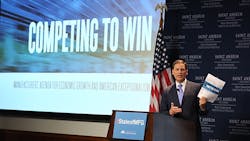NAM Offers Blueprint to Bolster Manufacturing Competitiveness
“We’re Americans. We want to win. We like to succeed,” Jay Timmons observes as he begins a cross-country “State of Manufacturing” tour that will take him to seven states over the next week. But Timmons, the president and CEO of the National Association of Manufacturers, says American manufacturers’ ability to compete successfully is hampered by a wide range of public policy issues that must be addressed if the United States is to maintain its “mantle of economic leadership.”
To aid in that effort, NAM has released a “Competing to Win” agenda offering policy recommendations for government leaders. The agenda, Timmons said, will provide political candidates with a blueprint that will “ensure that the manufacturing sector continues to strengthen and positions us well for the future.”
That blueprint covers a host of major issues, from taxes and trade to labor and health care. Timmons said now wasn’t the time to pick and choose one particular issue to help U.S. manufacturing.
“With a very competitive global economy, we really don’t have the luxury of sitting back and trying a few things here and there,” said the NAM leader. “We really have to move forward aggressively with a full agenda to enhance the manufacturing economy of our country.”
Leaving Washington, D.C. for “sunny and warm New Hampshire,” as Timmons quipped, he was scheduled on Thursday to tell a group at the New Hampshire Institute of Politics that manufacturing is transformed from the stereotype of “old, gritty factories, simple tools and rudimentary machines.” Instead, he explained in his remarks, manufacturing is leading an “innovation revolution” involving technologies such as the Internet of Things: “By some estimates, 26 billion objects will be linked together by the Internet by the year 2020. Manufacturing is truly changing everything…and all these things are changing America and changing our lives.”
But to have U.S. manufacturing achieve its full potential, Timmons says the U.S. needs to make policy changes just as many of its competitors have done.
“It’s not too hard. They have figured out that lower taxes, more transparent, effective and balanced regulation, a sounder legal system, more modern infrastructure, stronger trade agreements that open up markets– all of these things are the recipe for success,” he stressed.
With regard to taxes, Timmons reiterated the need for tax reform that lowers the corporate rate to 25% or less and moves to a territorial international tax system.
Timmons praised Congress for passing the multiyear surface transportation authorization bill and making the R&D tax credit permanent. His message in the next week, however, is that much more needs to be done.
“Our ports and inland waterways need to be upgraded to remain world class, and the U.S. aviation system, which catapulted the connectivity of nations and people, must remain second to none,” Timmons said in his New Hampshire speech. “If we don’t keep moving forward, transporting people and products in America will become slower, costlier and riskier.”
Something Timmons doesn’t want to see more of is costly environmental regulations such as the Obama administration’s greenhouse gas and ozone rules. He said U.S. industry has been a leader in reducing greenhouse gases, with manufacturers cutting these emissions by over 10% since 2005.
“What is frustrating is a lack of acknowledgement by this administration that manufacturers are eager to continue to lead the way but in order to do that, we need to strike a balance between these lofty and laudable ideals for the environment and what is actually commercially feasible,” he said.
Timmons said he was pleased that President Obama in his State of the Union address had “recognized the importance” of 900,000 manufacturing jobs restored during his administration, but Timmmons said manufacturing’s current state was a “mixed bag.” He noted international headwinds such as the strong U.S. dollar and slower growth in markets such as Asia. Those headwinds, he said, make it all the more important that U.S. policymakers tackle the issues outlined by NAM.
“Our point on this tour is that we need to redouble our commitment to exceptional American values – free enterprise, competitiveness, individual liberty and equal opportunity,” he said. “We need candidates that will inspire, unite and be solutions-driven, to focus on a manufacturing agenda that will grow our economy and create more jobs. That’s why we’re doing what we’re doing.”
About the Author
Steve Minter
Steve Minter, Executive Editor
Focus: Leadership, Global Economy, Energy
Call: 216-931-9281
Follow on Twitter: @SgMinterIW
An award-winning editor, Executive Editor Steve Minter covers leadership, global economic and trade issues and energy, tackling subject matter ranging from CEO profiles and leadership theories to economic trends and energy policy. As well, he supervises content development for editorial products including the magazine, IndustryWeek.com, research and information products, and conferences.
Before joining the IW staff, Steve was publisher and editorial director of Penton Media’s EHS Today, where he was instrumental in the development of the Champions of Safety and America’s Safest Companies recognition programs.
Steve received his B.A. in English from Oberlin College. He is married and has two adult children.
